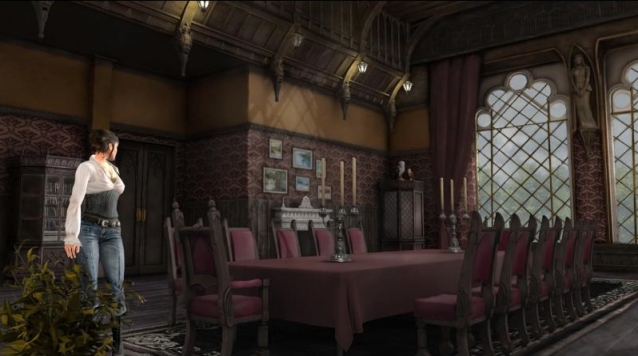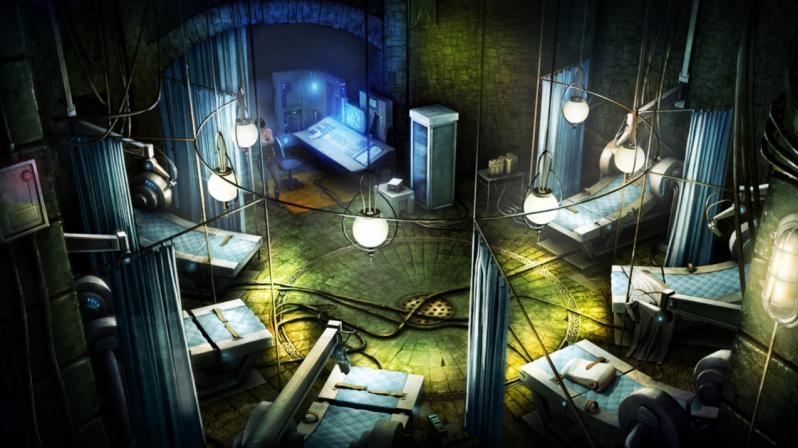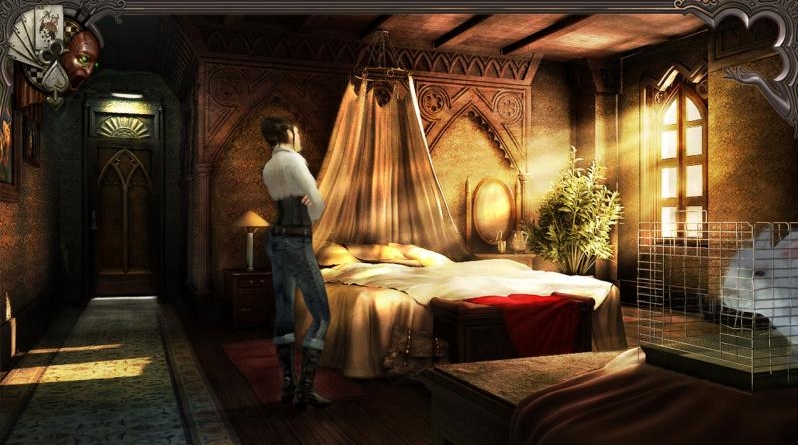Gray Matter Review
Developer: WizarBox
Publisher: DTP Entertainment / Lace Mamba Global
Available On: PC, Xbox 360 (Xbox 360 Version Reviewed)
When Jane Jensen’s first solo title, Gabriel Knight: Sins of the Fathers, was released in 1993, adventure gaming was riding a wave of huge success. PC Gaming was built around adventure games and the biggest selling and most acclaimed games were still from that genre. Each new release from Sierra, the publisher of Gabriel Knight, was hugely anticipated. Built around a strong grounding, both in historical fact and folklore, the game was an instant hit among more mature gamers.
Fast forward to 1999 and the release of Gabriel Knight: Blood of the Sacred, Blood of the Damned (the third installment in the series) was met with a much more unfavourable response. Adventure games were expensive to produce, took a long time to develop and were now declining in popularity. They were no longer the powerhouse of computer gaming that they once were. This third title met with critical success, and fans of the series lapped it up, but poor sales were the final nail in the coffin for Gabriel, and in turn, his creator. Sierra let go the majority of their staff who worked on adventure games and so ended an era for the company.
But what of the present day? For a game that has been in development on and off since 2003, Gray Matter has largely flown under the radar of most video game fans. Jane Jensen has been working on an entirely new character and story for the modern adventure gamer. After nine long years, Gray Matter has finally emerged as the latest offering from a master of the genre. But has the genre, or moreso gaming in general, passed her by?
STORY: In a suitably mysterious way, the game starts on a “dark and stormy night”. Sam Everett is an American trainee Magician, in England on the trail of a secret Magic Order called the Daedalus Club, which she has tracked down to London. On her way down from Liverpool, her Motorbike breaks down in the rain and she is forced to look for shelter. Finding only a large, spooky mansion, Sam discovers the building is in fact a clinic for the research of unusual neurological abnormalities. Posing as the new assistant to the owner, Dr. David Styles, Sam manages to find a bed for the night at Dread Hill House. Penniless, after discovering the house is located just outside of Oxford, Sam poses as a University student in an effort to make some money and fund her investigations into Daedalus.
Soon enough, Sam is tangled up in performing her duties as an assistant, and the secretive Doctor orders that she round up several Guinea Pigs for his next big experiment. Whilst finding some unfortunate students to volunteer, Sam also finds out that her employer has a shadowy past of his own, with a reputation to match. An accident several years ago has led to his name being dragged through the mud and his face to be disfigured. With great trepidation, Sam and the other students take part in the first experiment and it is then that things start to get really strange. A sequence of bizarre events around Oxford appear to be linked to the Doctor’s tests by more than mere coincidence, and Sam intends to find out what is really happening. As Magic and Science mix, the intrigue deepens and extraordinary revelations are revealed.
GRAPHICS: Most people who play Gray Matter will find the graphics somewhat of a contradiction. The first thing that hits you is the low quality, slideshow style opening cutscene. Made up entirely of illustrated characters moving in a juddering manner over hand-drawn backgrounds, every cinematic sequence in the game appears like this. Instantly the game gets off on the wrong foot as this kind of cutscene is of the standard one would expect to find in a freeware or casual online adventure game and certainly not a full Xbox 360 boxed release. It is not only the type of cutscenes that disappoint however, as characters are drawn in a strange style that doesn’t look quite right, for example, facial proportions seem a little off.
This is all the more confusing when compared to the fully rendered 3D character models used throughout gameplay for all characters, both important and background. Whilst not particularly technically impressive, these models are well animated and would look far better if used in cutscenes rather than the approach that was taken. Add in the fact that character faces appear in close-up when in conversation, featuring full lip-sync, and the clash between the drawn and rendered art is all the more apparent. That is not to say that the still artwork in the game is poor in any way. Drawn backgrounds are immensely detailed and atmospheric, and they add a great deal to the mood of the game.
The final point one must come to when discussing the game graphically is that the text in-game is a big problem. Here is where it can be seen clearly that the game was developed primarily for home computers. Whenever text appears on-screen it is far too small. Even subtitles are almost too small to read when playing from a couch. Obviously, if it were played on a computer monitor at a much closer range, this would not be an issue, but it is clear that text should have been scaled somewhat for the Xbox 360 version. In one case, the text labels on items available to purchase in the Magic Shop are so small that they are almost incomprehensible on a High Definition Television screen. Distance from the screen when playing on a games console is a factor that really should have been taken into consideration when the game was ported.
SOUND: The sound throughout Gray Matter is also somewhat of a mixed bag. The score to the game is very impressive. Composed by Robert Holmes, (who also put together the music for the Gabriel Knight series and is the Husband of Jane Jensen) a full orchestral film-style soundtrack is employed to great effect. The moodiness of the music really helps accent the atmosphere of the settings and situations Sam finds herself in. The music generally fits the location perfectly, although a few key themes are really overused throughout the game. For instance, the main Oxford theme plays throughout way too many scenes found in Oxford, when a slight change in the music to represent a change from one place to another would probably have been more effective.
Sound effects and voices vary wildly between authentic and irritating. Sound effects are in general good, and help accentuate the actions on-screen. Being set in England, the vast majority of voices throughout the game are for English characters. Some of these are perfectly fine, but a good deal of them have somewhat questionable, perhaps “Americanised” English accents. This does result in several characters sounding quite annoying and not particularly accurate. This would probably be far less noticeable to American users, or those from Germany (where the game was first released) but to an English ear, it just doesn’t quite sound right. When American voices are needed, they sounds fine, with the voice of Sam luckily being one of them. Sound effects too can be quite realistic, but sometimes repetitive background sounds will be unusually loud and irritating, illustrated by the noise Sam’s pet rabbit makes when it has escaped its cage. The noise is unnaturally audible when compared to other factors in the room, and the fact that it keeps playing at this volume (in order to alert you to the presence of the rabbit) can become annoying.
GAMEPLAY: For a fairly traditional-style adventure game, Gray Matter does integrate a few new ideas and gameplay mechanics that make it stand out as being unique from other similar games. But firstly, let me qualify this by saying that the implementation of gamepad controls into the game is far from perfect! This game was clearly made with mouse control in mind, and it suffers when played via the Xbox 360 controller. To map the controls from a mouse to the control pad, a Radial cursor has been introduced. Hold down one of the trigger buttons and a compass style dial appears, allowing the pointer to be controlled with the analog stick. Point to different objects and features around the room which will highlight when they can be interacted with. This would make perfect sense if an item to your left was assigned to the east-point of the compass, but it isn’t always. Sometimes dial directions do match up with geographical locations in the game, but often they don’t. In other words, a light that hangs from the ceiling may require the user to point diagonally down and to the left, then press A to interact with it! This is hardly intuitive.
Another issue that may make some less hardened adventurers shy away is the lack of a hint system. Now this would be no surprise to long-time adventure game fans as this never used to appear in the titles, but nowadays players have become used to their games being far more forgiving and helpful. There was a time when the only way to get help if you were stuck on a puzzle was to telephone a hint line, or ask friends, but lately games have come with built-in hint systems. These systems do often make games too easy however and thankfully Gray Matter steered clear of that pitfall. There is the option to turn hotspots on, so all items in the room will be labeled on-screen at once. This makes it easier to see what there is to investigate, but offers no insight into what is useful and what is not, therefore maintaining the difficulty at a reasonable level. It’s safe to say that a little more direction on what the objectives of each chapter are would be helpful, but by pressing a shoulder button, the player can view their chapter progress percentages, and the different task sub-headings do give a vague idea of what needs to be concentrated on.
Being a trainee Magician, Sam can use her magic tricks to get herself out of (or sometimes into) some tricky situations. This adds a different dynamic to the usual “pick up item, combine with second item, use on object” style of puzzles, and is a break from the long conversations. In a game mechanic which is very different from those in regular adventure games, the player can check through the Magician’s Guide book and choose particular tricks that would aid in certain situations that might prove impossible otherwise. After selecting the correct trick, a new window opens where combinations of sleight of hand, misdirection and even slipping items up your sleeve must be correctly put together in the right order to pull off the trick successfully. Each trick is outlined in the guide book, but players have to figure out what supplies are needed and when to execute them. This is a novel idea and a definite change of pace from other games. The amount of different tricks is somewhat limited, but tricking unwitting victims is an enjoyable alternative way of solving puzzles. Some chapters require the player to control Dr. Styles, but the gameplay will be identical in both cases, except for the fact Dr. Styles cannot perform the magic trick sections, so Sam is certainly the more interesting to control.
Other puzzles take the form of basic jigsaws, riddles and scavenger hunts, along with extensive conversation and information gathering, all of which are certainly not unique in adventuring circles, but it is the way they are linked in with both the local historical facts and elements such as magic and neuroscience that impresses. The strength in Jane Jensen’s games has always been her research, and the background knowledge and information players can access during the game is very impressive and comprehensive. Libraries can be accessed and file cabinets searched for extra data. Not everything is necessary, but the more effort the player puts into the game in terms of reading and pouring over the facts, the more rewarding the whole experience will be.
LONGEVITY: Being made up of several different chapters allows the game to be easily manageable when spread across multiple sessions. Each chapter could be looked upon as relatively self-contained and gamers could come back to one sometime after playing another, which is a nice feature for such a story-heavy title. Consisting of eight chapters, the game will last players a good amount of time. On average, each chapter may take around two hours to complete and, for what is a budget release, 16 hours plus of gameplay is a good length. Add to that the fact that each chapter also contains bonus items and puzzles that can be taken on if the player wishes to and there is some added motivation to return to the title and find everything there is to discover. Of course the Xbox 360 version also features Achievements which mostly unlock during a regular playthrough, but some will require players to hunt for every clue and 100% the game to gain the biggest Gamerscore possible.
VERDICT: A flawed title, there is no doubt, but many of its charms will shine through for those who persist with the game. There is no doubt that gamers will be somewhat put-off by first impressions, even those who are fans of the genre. Graphically and presentation-wise the game doesn’t seem like a full retail release. It could easily have been a download only title, and as a niche title, perhaps would have been more profitable had it been so.
Stick with it though, and the likable lead character, strong historical elements, unique puzzle solving methods and supernatural elements combine into an intriguing tale that urges you on to the end. It is a title that you will get a lot more from if you invest your time and effort into really exploring every facet of the game world, but perhaps that is too much to ask for many gamers of today.
So the question remains, has it all been worth the wait? Does it compare favourably to past glories? The answer, sadly, is probably not. Had this game come out almost ten years ago it wouldn’t even have been that revolutionary then! It wouldn’t have changed the face of gaming, and neither will it now. But for those who like to exercise their own grey matter, the storytelling and puzzle-solving form a winning combination, given enough time.








